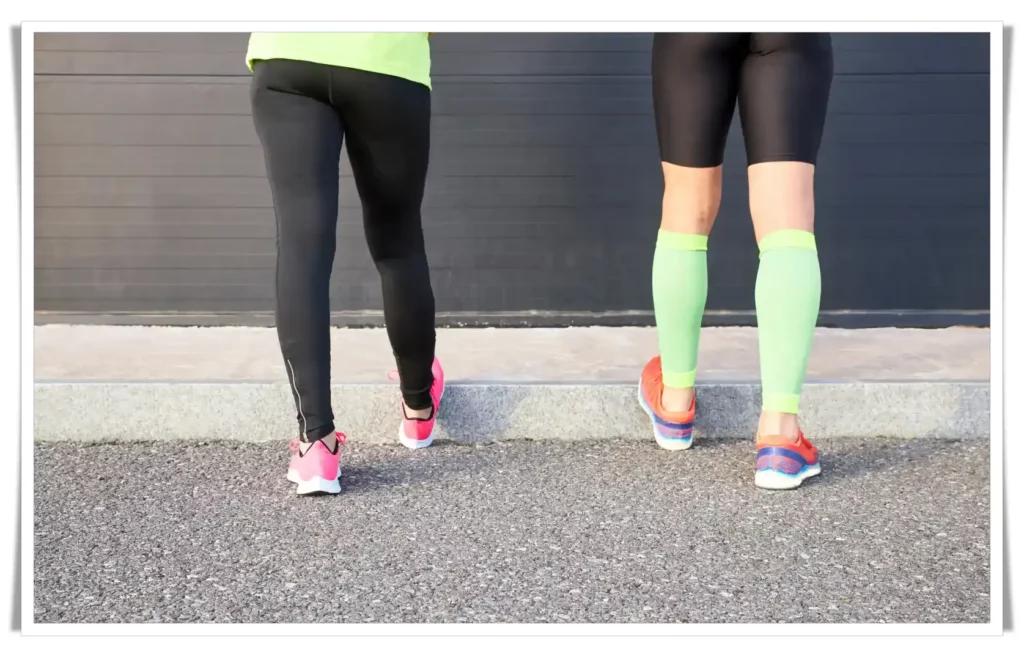There's an uncanny joy that comes from a good run: the rhythmic pounding of your feet on the pavement, the rush of endorphins, and the feeling of accomplishment as you push past personal limits. But a sudden stabbing pain in your side can halt your stride in a heartbeat. Most runners, from seasoned athletes to newbies, have experienced this at some point—the dreaded side stitch. In this comprehensive guide, we'll explore why we get stitches when running and how we can avoid them.
Empower Your Health Journey – Explore My Free Apps for a Vibrant, Healthier Lifestyle Today!
The Anatomy of a Stitch
There's a peculiar phenomenon that, despite its widespread familiarity among runners, remains somewhat shrouded in mystery — the side stitch. Often described as a sharp, stabbing pain, a side stitch can occur suddenly, hijacking your breath and putting a halt to your run. It strikes just below the ribs, most frequently on your left side, making it not just an uncomfortable interruption, but a palpable hindrance to your performance.
The scientific community recognizes this ailment as exercise-related transient abdominal pain (ETAP), a name that aptly captures its temporary yet troubling nature. Despite its commonplace occurrence, particularly in the realm of running, ETAP is not thoroughly understood. A range of hypotheses has been put forth, each attempting to explain why and how it strikes, yet the definitive cause of the side stitch remains elusive.
To visualize the areas commonly affected by a stitch, let's utilize Mermaid markdown syntax. With this, we can create a diagram that offers a simplified representation of the human torso and indicates the regions typically stricken by the infamous side stitch.
The diagram suggests the interconnectedness of these areas, highlighting how the pain may originate under the lower ribs but can radiate across the abdomen, encompassing a broader region and affecting the diaphragm in some instances.

Diving deeper into the topic, we find ourselves wading through a wealth of theories and propositions that have been made in an attempt to demystify the side stitch. While none of these have been definitively proven to be the sole cause of ETAP, each theory lends unique insights into the possible biological mechanisms that could be at play. It's through such cumulative scientific inquiry that we inch closer to understanding the causes behind this ubiquitous athletic discomfort.
From a perspective of anatomy, physiology, and the limitations of the human body, understanding why we get stitches when running can serve to enhance our overall approach to physical training. The more we learn about the enigma that is the side stitch, the better equipped we are to combat it and, ideally, prevent it from sabotaging our running routines.
The Interconnected Anatomy and the Enigma of Stitches
The body, as we know it, is an intricate system of interconnected parts. The manifestation of pain is often not confined to a single, isolated location. This is particularly true when we consider the nuisance of a stitch. As our Mermaid diagram illustrates, the origin of the discomfort may indeed be under the lower ribs, but the pain doesn't remain localized. It can spread, encompassing larger regions of the abdomen, and often impacting the diaphragm, the main muscle involved in our breathing process. This radiating pain underscores the interconnectedness of our anatomical structure.
Upon delving further into the enigma of the stitch, we're met with a panoply of scientific conjectures. Each of these theories, albeit unproven as the definitive cause of exercise-related transient abdominal pain (ETAP), offers compelling insights. They throw light on potential biological mechanisms that might be instrumental in triggering this discomfort. Whether it's the strain on the ligaments near the diaphragm, shallow breathing, or inadequate digestion of food and drink before a run — each explanation adds a piece to the complex puzzle of stitches.
Yet, the true cause of stitches remains elusive, shrouded in a cloak of scientific uncertainty. The theories are numerous and diverse, underscoring our lack of complete understanding of this common athletic discomfort. However, it's through these collective, incremental steps of scientific inquiry that we are gradually edging closer to a fuller understanding of this phenomenon.
Considering stitches from the lens of anatomy, physiology, and the limits of the human body can shed light on more than just the phenomenon itself. It also helps enhance our overall approach to physical training. Every piece of information we learn about the seemingly trivial side stitch adds to our arsenal of knowledge that can improve our training sessions.

Knowledge is power. In our quest to understand the cause of stitches, we're not just seeking a solution to a common problem. We're trying to gain an upper hand over a condition that can hamper our performance and hinder our progress. By piecing together the information we have, we can adapt our running techniques, breathing patterns, and pre-run habits. The objective is to mitigate the risk of encountering a stitch during our runs, or, in an ideal scenario, prevent it entirely.
Ultimately, the more we delve into the enigma of the side stitch, the better equipped we are to combat and neutralize this disruptive occurrence. We can transform our running experiences, progressing from simply enduring stitches to actively anticipating and avoiding them. Unraveling the mystery of stitches isn't just about curing discomfort—it's about empowering ourselves as runners and athletes.
Stitch-Proof Your Run: Comprehensive Strategies for Prevention and Treatment
When it comes to stitches, forewarned is forearmed. Knowledge of prevention and management techniques can significantly mitigate the risk of a stitch interrupting your running stride. Importantly, these strategies are closely intertwined with the multitude of theories put forth to explain the occurrence of stitches. By understanding and applying these techniques, we can potentially circumvent the sharp, jarring discomfort of a side stitch.
Pre-Run Nutrition: Timing and Selection is Key
Food is the fuel that powers our runs, but it's not just about what you eat, it's also about when you eat. The timing of your pre-run meal or snack can significantly influence the likelihood of a stitch striking. As a rule of thumb, you should avoid consuming large meals or drinking substantial quantities of liquid 1-2 hours before setting off on your run.
This timeframe allows your digestive system to process the food and drink adequately, thus reducing the chances of discomfort during your run. When it comes to hydration, water should be your preferred choice. Sports drinks or carbonated beverages, while potentially beneficial for replenishing electrolytes, may contribute to stomach upset and potentially lead to stitches.
Breathing Techniques: Rhythm and Depth Matter
The way you breathe, when you run, can have a profound impact on your performance and comfort. Practicing deep, rhythmic breathing can counteract the rapid, shallow breaths that are often implicated in the onset of stitches.

When you inhale, draw the breath deeply into your belly, expanding your diaphragm fully. Upon exhaling, ensure you breathe out fully, emptying your lungs and allowing fresh oxygen to circulate on your next breath. This practice of complete breath cycles may help prevent the onset of stitches and improve your overall stamina and running performance.
Posture: The Blueprint of Effective Running
How you carry yourself during a run can have significant implications for your running efficiency and comfort. The right running posture not only optimizes your energy expenditure but can also reduce the risk of a stitch.
To maintain a good running posture, keep your back straight and your chest lifted, facilitating easy breathing. Your arms should be bent at 90-degree angles at your sides, promoting effective arm swing and balance. This alignment ensures your muscles aren't being unduly squeezed or strained, reducing the likelihood of stitches and other muscular discomfort.
Warm-Up: The Essential Prelude to a Successful Run
The importance of a proper warm-up can't be overstated. Starting your run with a gentle warm-up prepares your body for the workout ahead, gradually increasing your heart rate and warming up your muscles. This can be as straightforward as a brisk walk or a slow jog.
Warming up not only helps prevent stitches but also reduces the risk of injuries. It's a small investment of time that yields significant dividends in terms of comfort and performance during your run.
Combatting the Onset of a Stitch
Despite the best preventive measures, a stitch might occasionally still strike. If that happens, there are steps you can take to alleviate the pain swiftly. Press firmly into the affected area — this manual pressure can often help to alleviate the discomfort.
Simultaneously, adopt a deep, even-paced breathing rhythm. Deep breaths can help relax the diaphragm and alleviate the sharp pain of a stitch.
With these strategies in hand, you're not just preparing for the possible eventuality of a stitch. You're also actively enhancing your running practice, making every stride more efficient and comfortable. Remember, understanding the physiology of running helps you harness the best of your potential, transforming every run into a harmonious symphony of perfectly timed actions.
Applying Science to Your Run: Understanding the Research
Scientific studies can provide powerful insights into the intricacies of running, offering evidence-based strategies for optimizing performance and comfort. One such study, published in the Journal of Science and Medicine in Sport, lends significant weight to the strategies we've discussed above, substantiating them with empirical evidence.
The Study and Its Findings
This particular research sought to examine the impact of adjustments in posture and breathing techniques on the frequency and severity of stitch occurrences. The investigators hypothesized that making specific changes in these two areas could lead to a notable decrease in stitch incidents among runners.

Their findings confirmed this hypothesis. The study concluded that deep, diaphragmatic breathing, coupled with maintaining a straight-backed running posture, contributed significantly to the reduction of stitch risks. This research adds an authoritative voice to the chorus advocating these specific preventive measures, providing a scientific basis for their effectiveness.
Breathing Techniques: A Deeper Look
The study emphasized the benefits of diaphragmatic breathing — a technique that involves drawing breaths deeply into the lungs, enabling the diaphragm to expand fully. This type of breathing is often contrasted with shallow, chest breathing, which typically involves short, rapid breaths that fail to fill the lungs completely.
In the context of running, the study suggests that adopting diaphragmatic breathing can not only help prevent the onset of stitches but also improve overall respiratory efficiency. Better respiratory efficiency can, in turn, enhance athletic performance, enabling runners to run longer and faster with less perceived effort.
Posture and Warm-Up: The Science Behind the Strategy
The research also sheds light on the relationship between running posture and stitches. It confirmed that maintaining a straight-back running posture could help mitigate stitch risks. An upright posture facilitates easier, deeper breathing, lessens muscular tension, and promotes better biomechanics, all of which can contribute to a decreased likelihood of experiencing a stitch.
In addition, the study underscored the importance of a thorough warm-up before a run. By gradually increasing the body's heart rate and warming up the muscles, a proper warm-up can help prepare the body for the physical exertion ahead, potentially reducing the chances of a stitch occurring.
Conclusions Drawn from the Research
In the end, this study reinforces the validity of the strategies discussed in our guide. By applying these science-backed techniques — deep diaphragmatic breathing, maintaining a straight-back posture, and ensuring a thorough warm-up — you're equipping yourself with effective tools to prevent the onset of stitches and improve your overall running experience.
Science continually enhances our understanding of running, shedding light on the biomechanics, physiology, and potential challenges of this popular form of exercise. With every new study, we gain insights that can help us become better, more efficient, and more comfortable runners. As such, staying informed about the latest research is an essential aspect of holistic running practice. Remember, the more we understand, the better we can run.
Here's the link to the study for a more detailed read. We encourage you to delve deeper into the research and apply the findings to your running routine.
Frequently Asked Questions
Throughout this article, we've covered various aspects of why we get stitches when running and how to avoid them. Here are some frequently asked questions to further enhance your understanding of this topic.
- What exactly is a stitch?
A stitch is a sharp, intense pain felt below the lower ribs, typically on the left side. It's also known as exercise-related transient abdominal pain (ETAP). - What causes stitches when running?
There are multiple theories, including rapid or shallow breathing, digestive factors, and inadequate warm-up before running. However, the exact cause remains unknown. - How can I avoid getting stitches while running?
Avoid eating substantial meals or drinking large volumes of liquids 1-2 hours before running. Practice deep, rhythmic breathing, maintain good posture, and ensure a proper warm-up before picking up your pace. - What should I do if I get a stitch while running?
Press firmly into the affected area and adopt deep, even-paced breathing. This should help alleviate the pain.
Reliable Sources for Further Reading
We encourage you to explore these reputable sources for further understanding:
- Runner's World
- American Running Association
- Journal of Science and Medicine in Sport
- Sports Medicine Open
Relevant Facts and Myths About Stitches
To wrap up, let's look at some common facts and myths related to stitches. Using a table format, we can summarise the key takeaways from this blog post and debunk some prevalent myths about stitches.
| Fact or Myth | Description |
|---|---|
| Fact | Stitches are more common among beginner runners due to their propensity to breathe rapidly and shallowly. |
| Myth | Drinking lots of water immediately before a run prevents stitches. In fact, consuming large amounts of liquid can potentially trigger a stitch. |
| Fact | Maintaining proper posture during running can help prevent stitches. |
| Myth | Stitches only occur on the left side. Actually, stitches can occur on either side, but they are more common on the left. |
| Fact | Deep, rhythmic breathing can help prevent stitches. |
For a visual recap, let's examine two different scenarios - a runner who incorporates the stitch prevention strategies we've discussed and one who does not.
In the first scenario, the runner follows all the recommended steps, leading to a comfortable, stitch-free run. In contrast, the second scenario shows a runner who overlooks these strategies and consequently experiences a painful stitch during their run. It serves as a visual reminder of the importance of taking the necessary precautions to prevent stitches, ultimately leading to a more enjoyable running experience.

In conclusion, stitches are a common, albeit uncomfortable, phenomenon that can disrupt your running experience. However, with the appropriate measures in place, such as adopting proper nutrition, hydration, and breathing techniques, maintaining correct posture, and ensuring a thorough warm-up, the occurrence of stitches can be significantly reduced.
Remember, every runner is unique, and what works best for you might require some experimentation. We hope this guide provides a helpful starting point in your quest for stitch-free runs.
Concluding the Race
Running is an immensely rewarding activity, but a sudden stitch can throw a spanner into the most enjoyable run. Understanding why we get stitches when running and how to avoid them will not only make your running experience more pleasant but also improve your performance.
Remember, if you're frequently experiencing stitches despite these preventative measures, it might be a good idea to consult a healthcare professional. Everyone's body is unique, and what works for one person might not work for another.
Do you have personal tips or experiences with running and stitches? We invite you to leave a comment below. Your insights could help other runners in our community!
For further reading, check out our article "The Power of Protein in Avocado: The Unexpectedly Low-Calorie Superfood" to discover how this nutritious fruit can boost your running energy levels. Additionally, diversify your fitness regimen by exploring our YouTube video, "Swimming for Weight Loss The Ultimate Guide to Slimming Down Through Swimming!".





Your hard work is appreciated; thank you for the excellent material.
Information that is shared is very valuable. I wanted to thank the author for sharing this work with me because I really enjoyed reading it. I am really appreciative that you sent me this blog post. Again, thank you. It’s awesome.
Wow, superb weblog structure! How lengthy have you ever been blogging
for? you make running a blog look easy. The overall look of your website is great, as smartly as the content material!
You can see similar: sklep online and here ecommerce
Wow, fantastic blog layout! How long have you ever been blogging for?
you make running a blog look easy. The whole glance of your site is
magnificent, let alone the content material! You can see similar: sklep internetowy and here
najlepszy sklep
I like the helpful information you provide in your articles.
I will bookmark your blog and check again here frequently.
I’m quite certain I’ll learn plenty of new stuff
right here! Best of luck for the next! I saw similar here: najlepszy sklep and also here: sklep